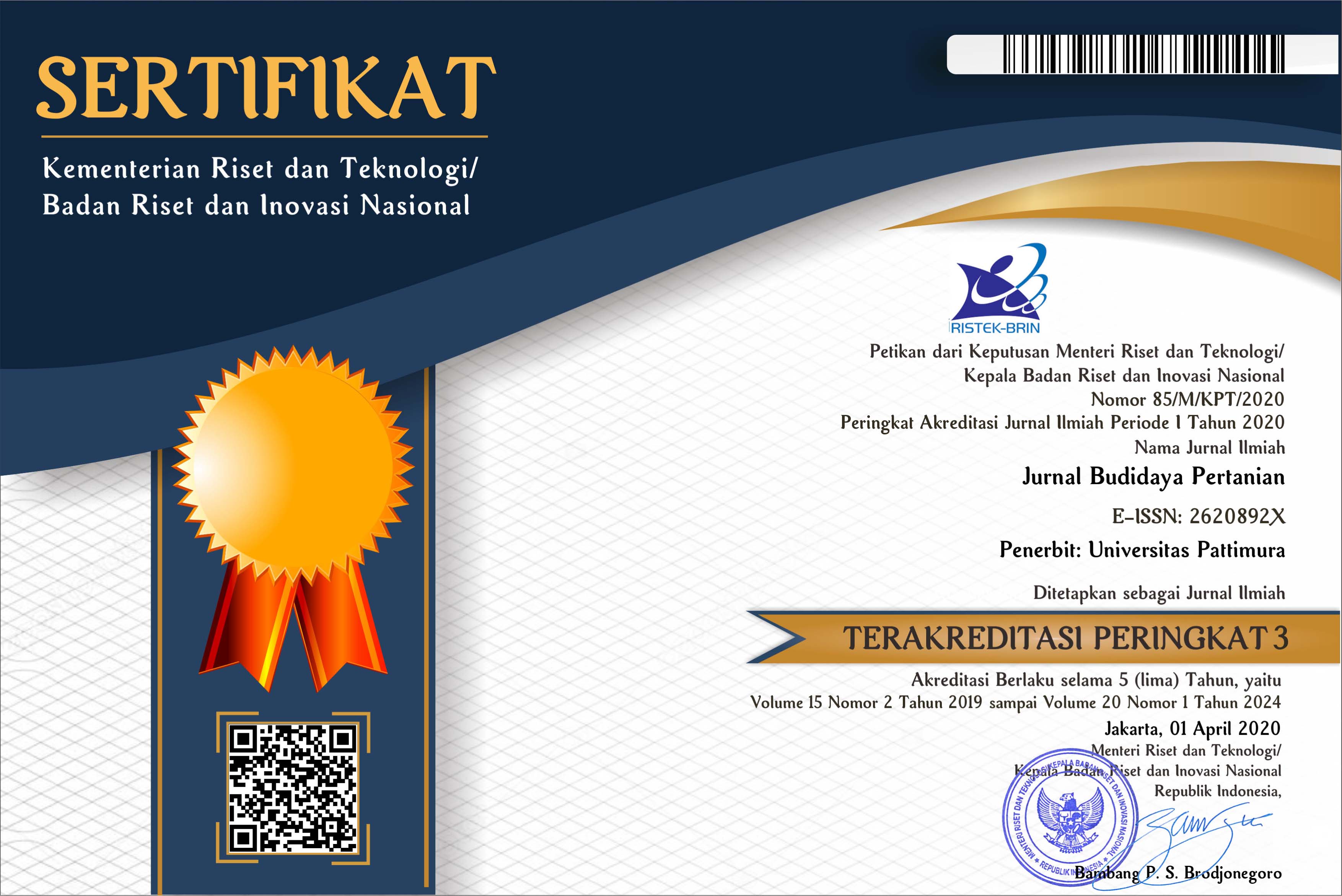Pengaruh Aplikasi Biostimulant terhadap Pertumbuhan dan Produksi Selada (Lactuca sativa L.)
Abstract
Lettuce is a type of vegetable that is very popular with the people of Indonesia. It contains healthy nutrients including minerals, vitamins, antioxidants, potassium, iron, folate, carotene, vitamin C and vitamin E. Biostimulants has the ability to stimulate new root formation, improve plant root systems, increase the number of tillers, and increase yield. Biostimulant concentration and site of administration play a role in providing nutrients for the needs of lettuce plants. To obtain the right concentration and place of administration for the growth and yield of lettuce, the experiment was carried out using a 2-factor Randomized Block Design. The first factor was the concentration of biostimulants (K) with 6 levels of concentration including: K0 (without giving biostimulants), K1 (giving biostimulants at a concentration of 1 mL/L of water), K2 (giving of biostimulants at 2 mL/L of water), K3 (giving biostimulants at 3 mL/L of water). K4 (giving biostimulant at 4 mL/L water), K5 (giving biostimulant at 5 mL/L water). The second factor was the site of administration (T), namely: T1 (through the leaves) and T2 (through the soil). The interaction between biostimulant concentration and administration gave a very significant effect on leaf number, crop fresh weight, root length and root number. Biostimulant concentration (K) gave the percentage of plant growth in the variables of plant height (34.29%) and leaf area (47.34%). Place of administration (T) gave percentage of plant growth the variables of leaf area (21.08%) and root wet weight (0.52%). The interaction of biostimulant concentration and administration place (K x T) gave the percentages of plant growth variables of leaf number (15.5%), plant fresh weight (52.33%), root dry weight (2.30%), root length (16.53%), and root number (108.5%). The best treatment in this study was the provision of biostimulant at a concentration of 2 mL/L of water that was given through leaves.
Keywords: administration place, biostimulant, concentration, growth and production, lettuce
ABSTRAK
Selada merupakan jenis sayur yang sangat digemari oleh masyarakat Indonesia serta mengandung nutrisi yang sehat, yang meliputi mineral, vitamin, antioksidan, potassium, zat besi, folat, karoten, vitamin C dan vitamin E. Biostimulan mampu merangsang pembentukan akar baru, memperbaiki sistem perakaran tanaman, memperbanyak jumlah anakan, dan meningkatkan produksi tanaman. Konsentrasi biostimulan dan tempat pemberian merupakan interaksi yang berperan dalam menyediakan unsur hara bagi kebutuhan tanaman selada. Untuk memproleh konsentrasi dan tempat pemberian yang tepat bagi pertumbuhan dan produksi tanaman selada, dilakukan percobaan dengan menggunakan Rancangan Acak Kelompok 2 faktor. Faktor pertama adalah pemberian biostimulan (K) dengan 6 taraf konsentrasi meliputi: K0 (tanpa pemberian biostimulan), K1 (pemberian biostimulan dengan konsentrasi 1 mL/L air), K2 (pemberian biostimulan 2 mL/L air), K3 (pemberian biostimulan 3 mL/L air), K4 (pemberian biostimulan 4 mL/L air), K5 (pemberian biostimulan 5 mL/L air). Faktor kedua adalah tempat pemberian (T), yaitu: T1 (melalui daun) dan T2 (melalui tanah). Interaksi konsentrasi biostimulan berpengaruh sangat nyata terhadap variabel jumlah daun (helai), bobot segar tanaman (g), panjang akar (cm) dan jumlah akar (helai). Pada konsentrasi biostimulan (K) memberikan persentasepertumbuhan tanaman pada variabel tinggi tanaman (34,29%) dan luas daun (47,34%), Tempat pemberian (T) memberikan persentasepertumbuhan tanaman pada variabel luas daun (21,08%), bobot basah akar (0,52%), serta interaksi konsentrasi biostimulan dan tempat pemberian (KT) memberikan persentasepertumbuhan tanaman pada variabel jumlah daun (15,5%), bobot segar tanaman (52,33%), bobot kering akar (2,30%), panjang akar (16,53%), serta jumlah akar (108,5%). Perlakuan terbaik dalam penelitian ini adalah pemberian biostimulan konsentrasi 2 mL/L air dan diberikan melalui daun.
Kata Kunci: biostimulan, konsentrasi, pertumbuhan dan produksi, selada, tempat pemberian,
Downloads
References
Anonim, 2013. Biostimulants Market - By Active Ingredients, Applications, Crop Types dan Geography - Global Trends dan Forecasts to 2018. http://www.marketresearch.com/land/ product.asp?productid=7618776&progid=85504
Berlyn, G.P. and S. Sivaramakrishnan. 1997. The Use of Organic Biostimulants to Reduce Fertilizer Use, Increase Stress Resistance, and Promote Growth. Paper presented at the Northeastern Forest Nursery Association Conference, August 19-22, 1996, New England, Connecticut. National Proceedings, Forest and Conservation Nursery Associations. U.S. Dept. of Agriculture, Forest Service, Pacific Northwest Research Station
Craigie, J.S. 2011. Sea weed extract stimuli in plant science and agriculture. J. Appl. Phycol. 23:371-393. DOI: 10.1007/s10811-010-9560-4
Kesaulya. H. 2015. Bioprospek Rizobakteria Asal Kentang (Solanum tuberosum L.) Var. Hartapel Sebagai Pemacu Pertumbuhan Tanaman. Desertasi. Universitas Hasannudin, Makassar.
Lingga, P. dan Marsono. 2008. Petunjuk Pengguna Pupuk. Penebar Swadaya, Depok.
Sa’daiah. H. 2015. Pengaruh Pemberian Pupuk Organik Cair Urin Kelinci pada Tanaman Selada Merah (Lactuca sativa L.). Laporan Akhir. Tahun 2015. Politeknik Pertanian Negeri Bayakumbah.
Samadi, B. 2014. Rahasia Budidaya Selada Secara Organik dan Anorganik. Pustaka Mina, Jakarta.
Santoso, D. dan Priyono. 2014. Proses produksi dan formulasi biostimulan dari alga coklat Sargassum sp. serta penggunaannya untuk pertumbuhan tanaman. Paten Negara Indonesia. Nomor Permohonan P00201406718.
Sharma, H.S.S., C. Selby, E. Carmichael, C. McRoberts, J.R. Rao, P. Ambrosino, M. Chiurazzi, M. Pucci, and T. Martin. 2016. Physicochemical analyses of plant biostimulant formulations and characterisation of commercial products by instrumental techniques. Chem. Biol. Technol. Agric. 13: 1-17. DOI 10.1186/s40538-016-0064-6.
Singh, H., M.K. Singh, S.K. Pal, R. Thakur, S.T. Zodape, and A. Ghosh. 2015. Use of seaweed sap for sustainable productivity of maize. Bioscan 10: 1349-1355.
Syltie, P.W. 2011. Vitazyme an All Natural Biostimulant Concentrate. A Summary of Experiments Using Viatzyme Soil and Plant Biostimulant on Field, Orchard, and Greenhouse Crops. Texas, U.S.A.
USDA. 2018. Lettuce, green leaf, raw - Nutrients. FoodData Central, Agricultural Research Services, US Department of Agriculture. https://fdc.nal.usda.gov/fdc-app.html#/food-details/ 169249/nutrients
Velez, P.P., L. Nelson, and J.W. Kloepper. 2014. Agricultural uses of plant biostimulants. Plant Soil 383:3-41. DOI: https://doi.org/10.1007/ s11104- 014-2131-8.
Copyright (c) 2020 Primarine R Tahapary, Herman Rehatta, Henry Kesaulya

This work is licensed under a Creative Commons Attribution-ShareAlike 4.0 International License.

 Accreditation is valid for 5 years, starting from Volume 15 Issues 2 December 2019 up to Volume 20 Issue 1 June 2024.
Accreditation is valid for 5 years, starting from Volume 15 Issues 2 December 2019 up to Volume 20 Issue 1 June 2024.






